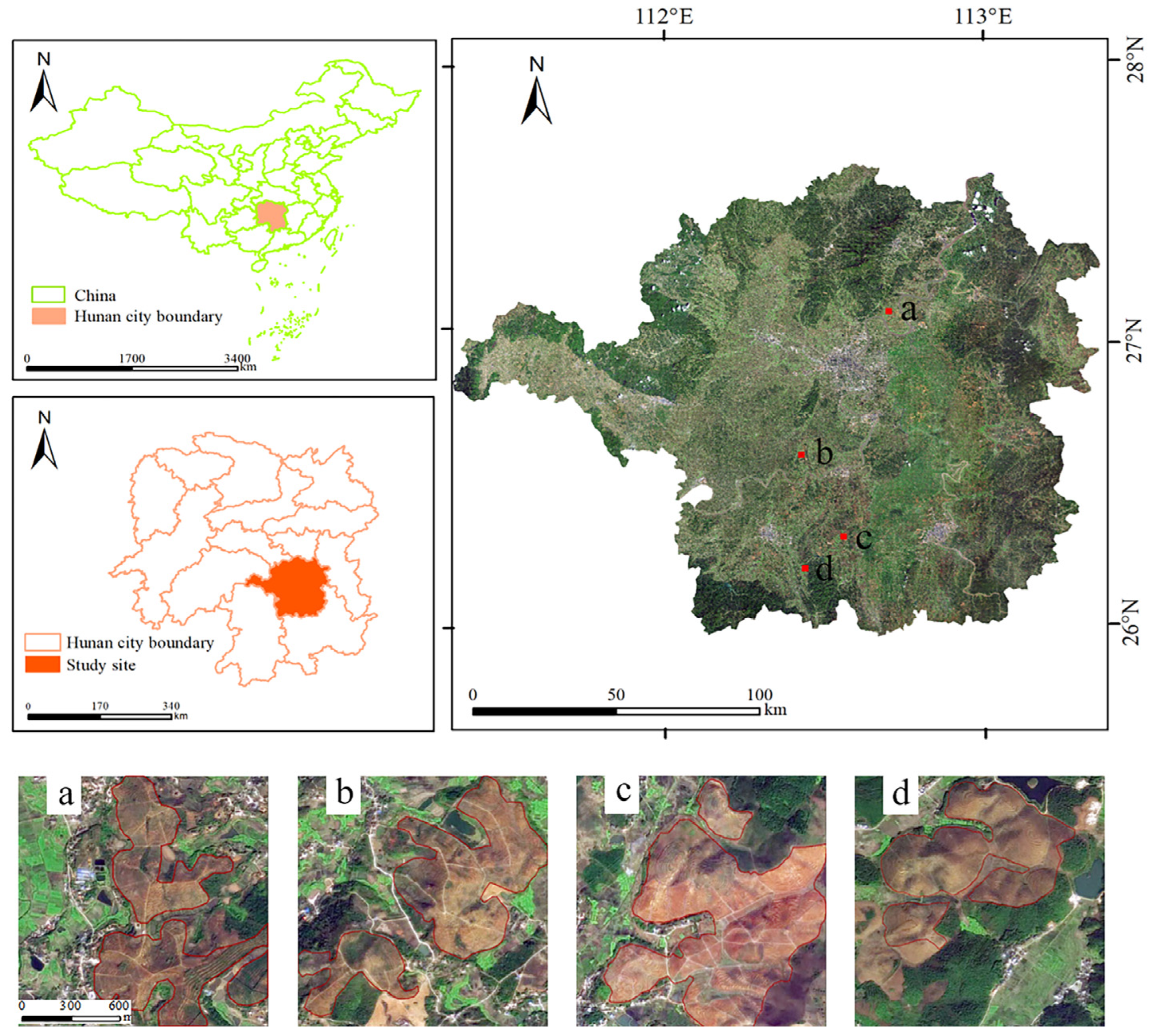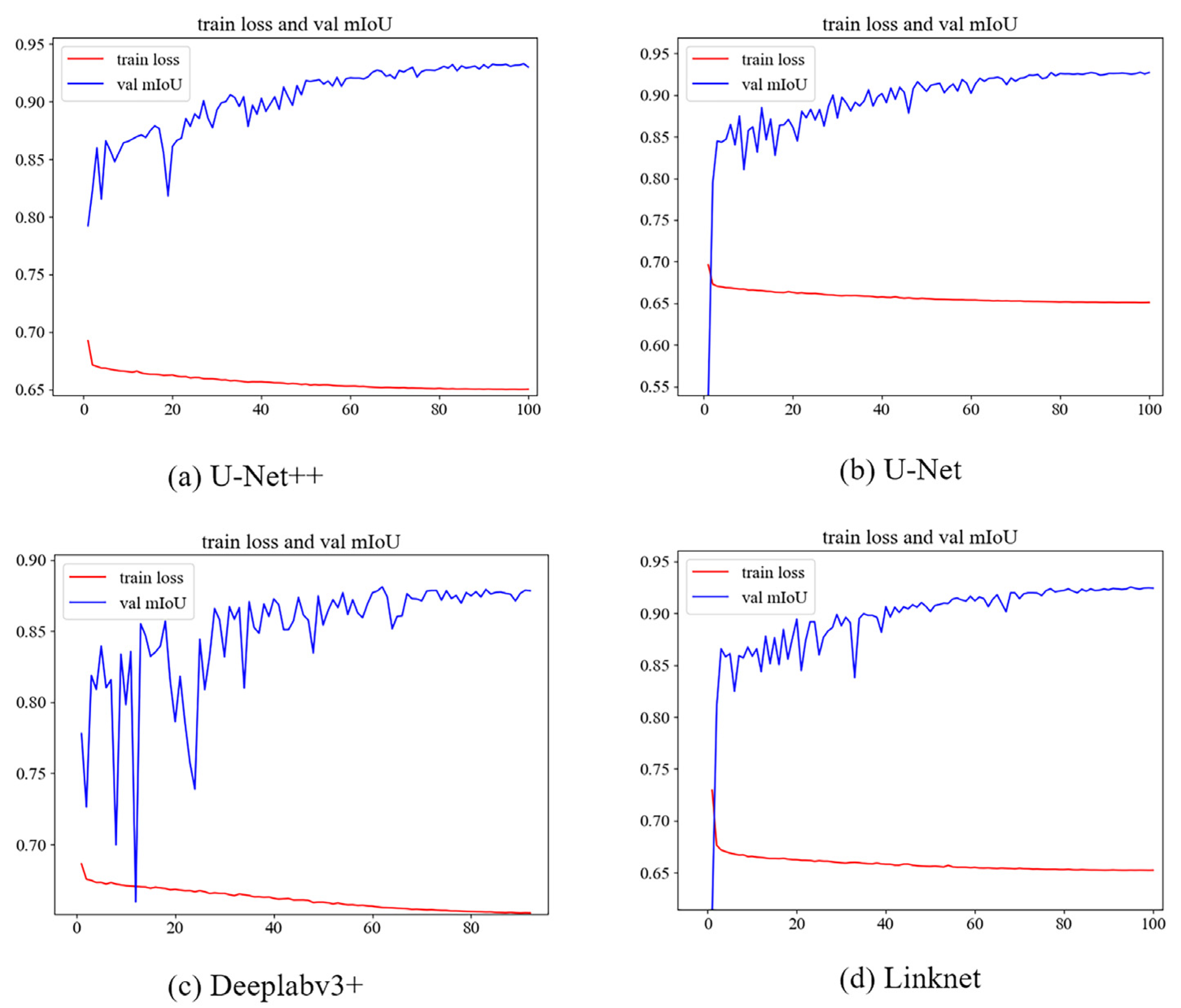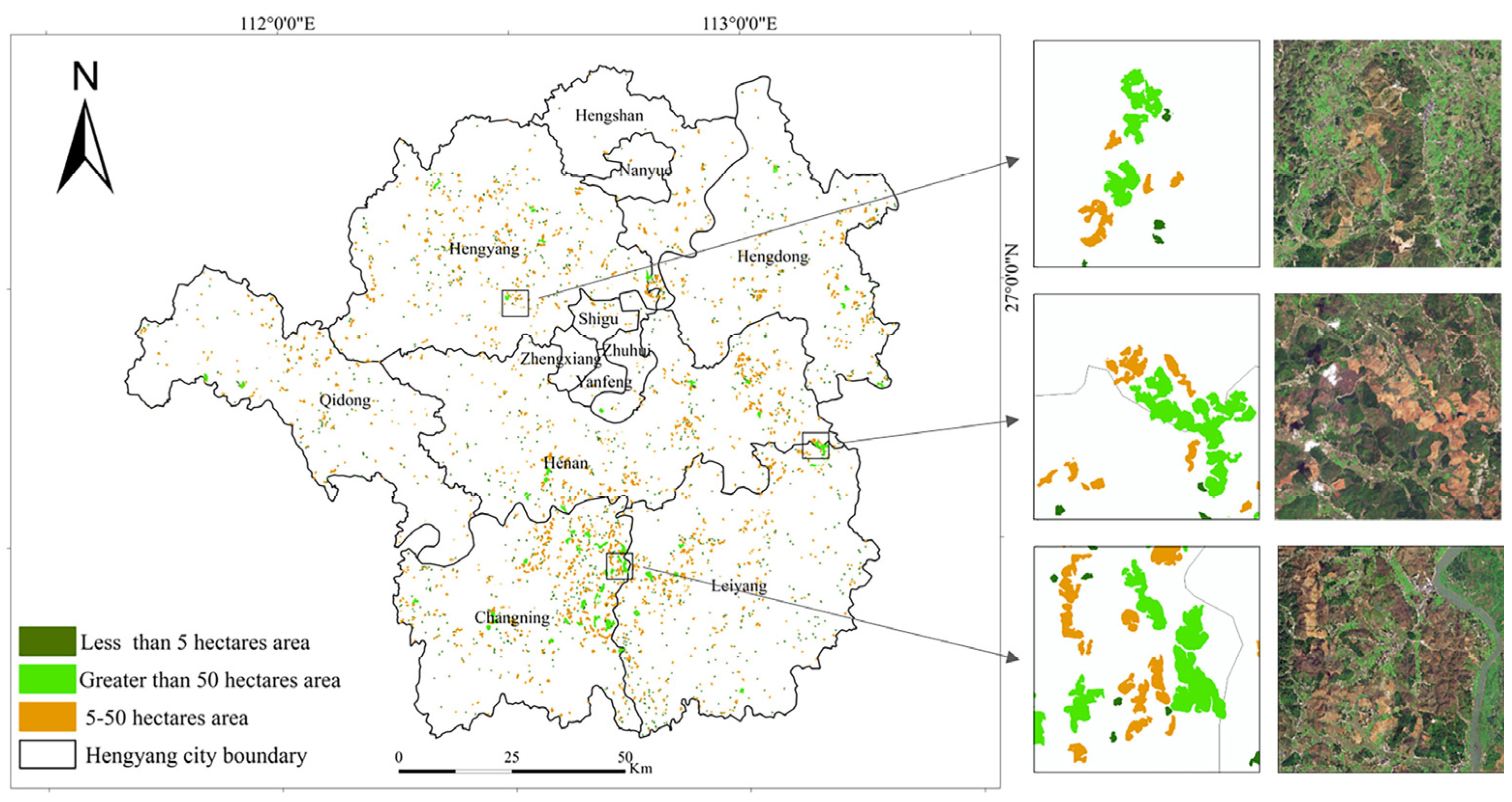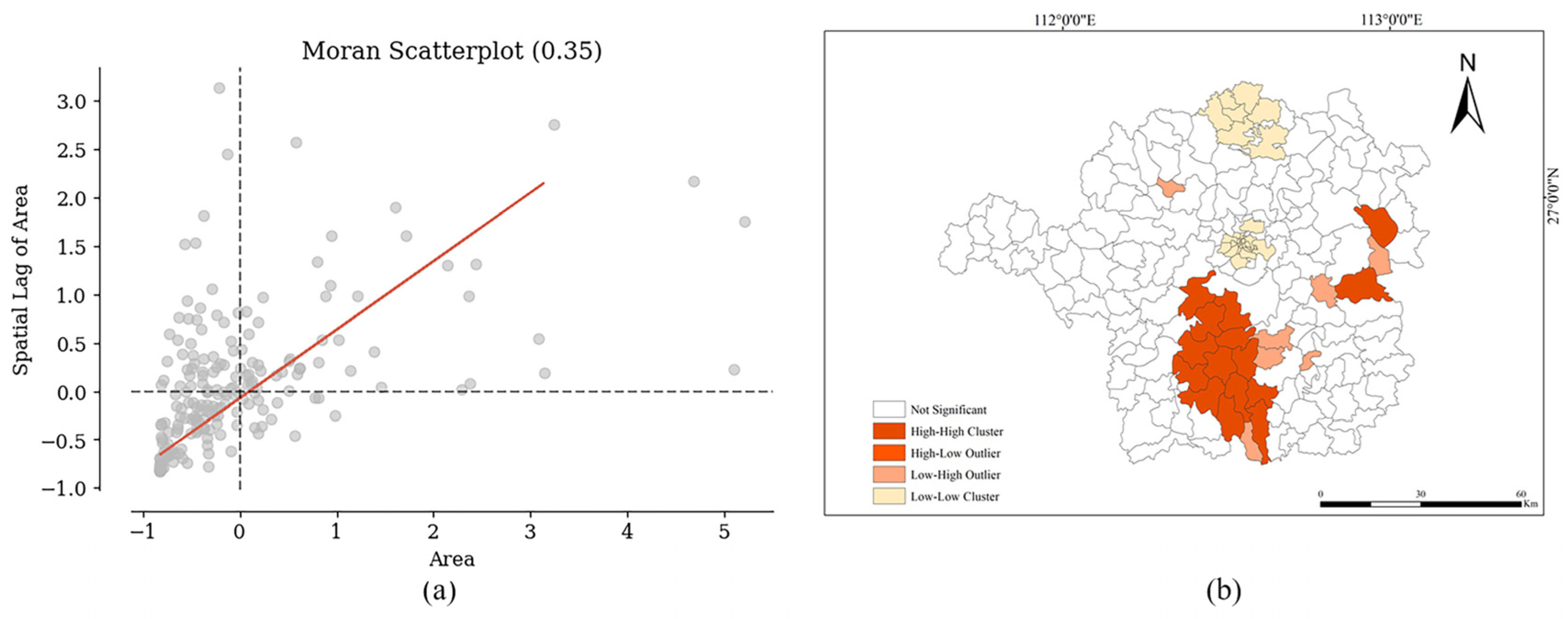Investigating the Identification and Spatial Distribution Characteristics of Camellia oleifera Plantations Using High-Resolution Imagery
Abstract
:1. Introduction
2. Materials and Methods
2.1. Study Area
2.2. Data and Preprocessing
2.2.1. Data Sources
- (1)
- Remote Sensing Image Data: As shown in Table 1, in this study, we utilized high-resolution remote sensing imagery derived from a fusion of multiple GF-2 images captured in 2020. These images underwent a series of preprocessing steps, including orthorectification, radiometric calibration, image fusion, mosaicking, and color balancing, to enhance the accuracy and clarity of the remote sensing data. The preprocessed GF-2 images encompass multispectral information across four bands: red, green, blue, and near-infrared (sRGB). However, for the purposes of this study, only the red, green, and blue bands were employed. Initially, the spatial resolution of these high-resolution images was 3.2 m, but post resampling, it was refined to 2 m. All preprocessing tasks were executed using scripts developed in Pycharm. The predilection for high-resolution imagery stems from the potential ambiguity between Camellia oleifera plantations and other vegetative or terrestrial features in lower-resolution images. Such high-resolution captures substantially mitigate these ambiguities, fortifying the precision in extracting Camellia oleifera plantation areas. Additionally, the 30 m spatial resolution DEM data from NASA’s Shuttle Radar Topography Mission (SRTM) were gathered for a thorough analysis of the spatial distribution characteristics of the Camellia oleifera plantation areas.
- (2)
- Auxiliary Data: The research employs high-resolution, 18-level Google Earth images (with a spatial resolution of 0.54 m) and “Woodland Resources Map” data as additional resources. Access to the Google Maps platform and the use of pertinent tools facilitated the acquisition of these Google Earth images. These images provide a reliable basis for deep-learning label generation in Camellia oleifera plantation areas. Furthermore, the “Woodland Resources Map” is constructed by distinctly categorizing forested and non-forested areas. This implies that non-forested regions are excluded, thereby minimizing interference factors associated with them. Such an approach enhances the precision of subsequent analyses concerning the spatial distribution characteristics of Camellia oleifera plantations.
2.2.2. Dataset
2.3. Semantic Segmentation
2.3.1. Model Selection
2.3.2. Network Parameter Selection
2.3.3. Model Evaluation Metrics
2.3.4. Accuracy Validation
2.4. Analysis of Spatial Distribution for Camellia oleifera Plantations
2.5. Evaluation of Spatial Aggregation Characteristics in Camellia oleifera Plantation Areas
2.5.1. Global Moran’s Index
2.5.2. Local Moran’s Index
2.6. Analysis of Camellia oleifera Plantation Patch Fragmentation
2.6.1. Average Patch Size
2.6.2. Index of Patch Number Fragmentation
3. Results
3.1. Analysis of Model Training and Validation Efficiency
3.2. Performance Evaluation of the Train Model
3.3. Accuracy Validation
3.4. Analysis of Camellia oleifera Plantation Prediction Results
3.5. Analysis of Spatial Distribution Characteristics in Camellia oleifera Plantations
3.5.1. Characteristics of Area Distribution
3.5.2. Topographical Distribution Characteristics
3.6. Aggregation Characteristics Analysis of Camellia oleifera Plantations
3.6.1. Global Moran’s Index
3.6.2. Local Moran’s Index
3.7. Examination of Camellia oleifera Plantation Patch Fragmentation
4. Discussion
4.1. Performance Evaluation of Models
4.2. The Distribution of Camellia oleifera Plantations in Hengyang City
4.3. The Distribution Characteristics of Camellia oleifera Plantations on Different Terrains
4.4. Spatial Aggregation Analysis of Camellia oleifera Plantations
4.5. Examination of Camellia oleifera Plantation Patch Fragmentation
4.6. Outlook
5. Conclusions
Author Contributions
Funding
Data Availability Statement
Conflicts of Interest
References
- Deng, Q.; Li, J.; Gao, C.; Cheng, J.; Deng, X.; Jiang, D.; Li, L.; Yan, P. New perspective for evaluating the main Camellia oleifera cultivars in China. Sci. Rep. 2020, 10, 20676. [Google Scholar] [CrossRef]
- Rogan, J.; Chen, D. Remote sensing technology for mapping and monitoring land-cover and land-use change. Prog. Plan. 2004, 61, 301–325. [Google Scholar] [CrossRef]
- Prokop, P. Tea plantations as a driving force of long-term land use and population changes in the Eastern Himalayan piedmont. Land Use Policy 2018, 77, 51–62. [Google Scholar] [CrossRef]
- Wei, Y.; Tong, X.; Chen, G.; Liu, D.; Han, Z. Remote detection of large-area crop types: The role of plant phenology and topography. Agriculture 2019, 9, 150. [Google Scholar] [CrossRef]
- Xu, X.; Zhang, L.; Chen, L.; Wei, F. Does COVID-2019 have an impact on the purchase intention of commercial long-term care insurance among the elderly in China? Healthcare 2020, 8, 126. [Google Scholar] [CrossRef]
- Shanahan, J.F.; Schepers, J.S.; Francis, D.D.; Varvel, G.E.; Wilhelm, W.W.; Tringe, J.M.; Schlemmer, M.R.; Major, D.J. Use of remote-sensing imagery to estimate corn grain yield. Agron. J. 2001, 93, 583–589. [Google Scholar] [CrossRef]
- Danylo, O.; Pirker, J.; Lemoine, G.; Ceccherini, G.; See, L.; McCallum, I.; Hadi; Kraxner, F.; Achard, F.; Fritz, S. A map of the extent and year of detection of oil palm plantations in Indonesia, Malaysia and Thailand. Sci. Data 2021, 8, 96. [Google Scholar] [CrossRef]
- Xiao, X.; Boles, S.; Frolking, S.; Li, C.; Babu, J.Y.; Salas, W.; Moore, B., III. Mapping paddy rice agriculture in South and Southeast Asia using multi-temporal MODIS images. Remote Sens. Environ. 2006, 100, 95–113. [Google Scholar] [CrossRef]
- Zhao, C. Advances of research and application in remote sensing for agriculture. Nongye Jixie Xuebao/Trans. Chin. Soc. Agric. Mach. 2014, 45, 277–293. [Google Scholar]
- Deng, L. The mnist database of handwritten digit images for machine learning research [best of the web]. IEEE Signal Process. Mag. 2012, 29, 141–142. [Google Scholar] [CrossRef]
- Brown, J.C.; Kastens, J.H.; Coutinho, A.C.; de Castro Victoria, D.; Bishop, C.R. Classifying multiyear agricultural land use data from Mato Grosso using time-series MODIS vegetation index data. Remote Sens. Environ. 2013, 130, 39–50. [Google Scholar] [CrossRef]
- Julien, Y.; Sobrino, J.A.; Jiménez-Muñoz, J.-C. Land use classification from multitemporal Landsat imagery using the Yearly Land Cover Dynamics (YLCD) method. Int. J. Appl. Earth Obs. Geoinf. 2011, 13, 711–720. [Google Scholar] [CrossRef]
- Descals, A.; Szantoi, Z.; Meijaard, E.; Sutikno, H.; Rindanata, G.; Wich, S. Oil palm (Elaeis guineensis) mapping with details: Smallholder versus industrial plantations and their extent in Riau, Sumatra. Remote Sens. 2019, 11, 2590. [Google Scholar] [CrossRef]
- Guo, Y.; Liu, Y.; Georgiou, T.; Lew, M.S. A review of semantic segmentation using deep neural networks. Int. J. Multimed. Inf. Retr. 2018, 7, 87–93. [Google Scholar] [CrossRef]
- Garcia-Garcia, A.; Orts-Escolano, S.; Oprea, S.; Villena-Martinez, V.; Garcia-Rodriguez, J. A review on deep learning techniques applied to semantic segmentation. arXiv 2017, arXiv:1704.06857. [Google Scholar]
- Gao, L.; Liu, H.; Yang, M.; Chen, L.; Wan, Y.; Xiao, Z.; Qian, Y. STransFuse: Fusing swin transformer and convolutional neural network for remote sensing image semantic segmentation. IEEE J. Sel. Top. Appl. Earth Obs. Remote Sens. 2021, 14, 10990–11003. [Google Scholar] [CrossRef]
- Long, J.; Shelhamer, E.; Darrell, T. Fully convolutional networks for semantic segmentation. In Proceedings of the IEEE Conference on Computer Vision and Pattern Recognition, Boston, MA, USA, 7–12 June 2015; pp. 3431–3440. [Google Scholar]
- Zhou, Z.; Li, S. Peanut planting area change monitoring from remote sensing images based on deep learning. In Proceedings of the 2017 4th International Conference on Systems and Informatics (ICSAI), Hangzhou, China, 11–13 November 2017; pp. 1358–1362. [Google Scholar]
- Ronneberger, O.; Fischer, P.; Brox, T. U-net: Convolutional networks for biomedical image segmentation. In Proceedings of the Medical Image Computing and Computer-Assisted Intervention–MICCAI 2015: 18th International Conference, Munich, Germany, 5–9 October 2015; pp. 234–241. [Google Scholar]
- Wei, S.; Zhang, H.; Wang, C.; Wang, Y.; Xu, L. Multi-temporal SAR data large-scale crop mapping based on U-Net model. Remote Sens. 2019, 11, 68. [Google Scholar] [CrossRef]
- Zhou, Z.; Siddiquee, M.M.R.; Tajbakhsh, N.; Liang, J. Unet++: Redesigning skip connections to exploit multiscale features in image segmentation. IEEE Trans. Med. Imaging 2019, 39, 1856–1867. [Google Scholar] [CrossRef]
- Zhou, Z.; Siddiquee, M.; Tajbakhsh, N.; Liang, J.U. A nested U-Net architecture for medical image segmentation. arXiv 2018, arXiv:1807.10165. [Google Scholar]
- Tu, J.; Chen, J.; Zhou, J.; Ai, W.; Chen, L. Plantation quality assessment of Camellia oleifera in mid-subtropical China. Soil Tillage Res. 2019, 186, 249–258. [Google Scholar] [CrossRef]
- Hoorali, F.; Khosravi, H.; Moradi, B. Automatic Bacillus anthracis bacteria detection and segmentation in microscopic images using UNet++. J. Microbiol. Methods 2020, 177, 106056. [Google Scholar] [CrossRef] [PubMed]
- Chen, L.-C.; Zhu, Y.; Papandreou, G.; Schroff, F.; Adam, H. Encoder-decoder with atrous separable convolution for semantic image segmentation. In Proceedings of the European Conference on Computer Vision (ECCV), Munich, Germany, 8–14 September 2018; pp. 801–818. [Google Scholar]
- Chaurasia, A.; Culurciello, E. Linknet: Exploiting encoder representations for efficient semantic segmentation. In Proceedings of the 2017 IEEE Visual Communications and Image Processing (VCIP), Petersburg, FL, USA, 10–13 December 2017; pp. 1–4. [Google Scholar]
- Xiang, J.; Xing, Y.; Wei, W.; Yan, E.; Jiang, J.; Mo, D. Dynamic Detection of Forest Change in Hunan Province Based on Sentinel-2 Images and Deep Learning. Remote Sens. 2023, 15, 628. [Google Scholar] [CrossRef]
- Langer, S. Approximating smooth functions by deep neural networks with sigmoid activation function. J. Multivar. Anal. 2021, 182, 104696. [Google Scholar] [CrossRef]
- Badrinarayanan, V.; Kendall, A.; Cipolla, R. Segnet: A deep convolutional encoder-decoder architecture for image segmentation. IEEE Trans. Pattern Anal. Mach. Intell. 2017, 39, 2481–2495. [Google Scholar] [CrossRef]
- Hand, D.; Christen, P. A note on using the F-measure for evaluating record linkage algorithms. Stat. Comput. 2018, 28, 539–547. [Google Scholar] [CrossRef]
- Wu, D.; Wang, P.; Huo, Z.; Yuan, X.; Jiang, H.; Yang, J.; Tang, J.; Ma, Y. Changes in climate suitability for oil-tea (C. oleifera Abel) production in China under historical and future climate conditions. Agric. For. Meteorol. 2022, 316, 108843. [Google Scholar] [CrossRef]
- Fu, W.J.; Jiang, P.K.; Zhou, G.M.; Zhao, K.L. Using Moran’s I and GIS to study the spatial pattern of forest litter carbon density in a subtropical region of southeastern China. Biogeosciences 2014, 11, 2401–2409. [Google Scholar] [CrossRef]
- Bryan-Brown, D.N.; Connolly, R.M.; Richards, D.R.; Adame, F.; Friess, D.A.; Brown, C.J. Global trends in mangrove forest fragmentation. Sci. Rep. 2020, 10, 7117. [Google Scholar] [CrossRef]
- Ma, J.; Li, J.; Wu, W.; Liu, J. Global forest fragmentation change from 2000 to 2020. Nat. Commun. 2023, 14, 3752. [Google Scholar] [CrossRef]
- Qi, J.; Lu, Y.; Han, F.; Ma, X.; Yang, Z. Spatial distribution characteristics of the rural tourism villages in the Qinghai-Tibetan Plateau and its influencing factors. Int. J. Environ. Res. Public Health 2022, 19, 9330. [Google Scholar] [CrossRef]
- Toosi, N.B.; Soffianian, A.R.; Fakheran, S.; Waser, L.T. Mapping disturbance in mangrove ecosystems: Incorporating landscape metrics and PCA-based spatial analysis. Ecol. Indic. 2022, 136, 108718. [Google Scholar] [CrossRef]













| Data Series | Name of Data | Data Source | Spatial Resolution (m) | Time |
|---|---|---|---|---|
| Remote sensing data | GF-2 | Academy of Forestry Inventory and Planning, State Forestry, Administration, China | 2 | 2020 |
| DEM | SRTM | 30 | / | |
| Auxiliary Data | Woodland Resources Map | Academy of Forestry Inventory and Planning, State Forestry, Administration, China | / | 2020 |
| Google Earth image | Google Maps Platform | 0.5 | 2020 |
| Dataset | Train Dataset | Val Dataset | Test Dataset | All Dataset |
|---|---|---|---|---|
| Number of samples | 6111 | 764 | 764 | 7639 |
| Map Data | |||||
|---|---|---|---|---|---|
| Other Crops | Camellia oleifera | Total | Producer’s Accuracy | ||
| Hengnan County | |||||
| Validation Data | Other Crops | 159 | 17 | 176 | 90.34% |
| Camellia oleifera | 19 | 162 | 181 | 89.50% | |
| Total | 178 | 179 | 357 | ||
| User’s Accuracy | 89.33% | 90.50% | |||
| Overall Accuracy | 89.92% | ||||
| Qidong County | |||||
| Validation Data | Other Crops | 130 | 10 | 140 | 92.86% |
| Camellia oleifera | 23 | 113 | 136 | 83.09% | |
| Total | 153 | 123 | 276 | ||
| User’s Accuracy | 84.97% | 91.87% | |||
| Overall Accuracy | 87.98% | ||||
| Hengdong County | |||||
| Validation Data | Other Crops | 117 | 8 | 125 | 93.60% |
| Camellia oleifera | 12 | 112 | 124 | 90.32% | |
| Total | 129 | 120 | 249 | ||
| User’s Accuracy | 90.70% | 93.33% | |||
| Overall Accuracy | 93.40% | ||||
Disclaimer/Publisher’s Note: The statements, opinions and data contained in all publications are solely those of the individual author(s) and contributor(s) and not of MDPI and/or the editor(s). MDPI and/or the editor(s) disclaim responsibility for any injury to people or property resulting from any ideas, methods, instructions or products referred to in the content. |
© 2023 by the authors. Licensee MDPI, Basel, Switzerland. This article is an open access article distributed under the terms and conditions of the Creative Commons Attribution (CC BY) license (https://creativecommons.org/licenses/by/4.0/).
Share and Cite
Li, Y.; Yan, E.; Jiang, J.; Cao, D.; Mo, D. Investigating the Identification and Spatial Distribution Characteristics of Camellia oleifera Plantations Using High-Resolution Imagery. Remote Sens. 2023, 15, 5218. https://doi.org/10.3390/rs15215218
Li Y, Yan E, Jiang J, Cao D, Mo D. Investigating the Identification and Spatial Distribution Characteristics of Camellia oleifera Plantations Using High-Resolution Imagery. Remote Sensing. 2023; 15(21):5218. https://doi.org/10.3390/rs15215218
Chicago/Turabian StyleLi, Yajing, Enping Yan, Jiawei Jiang, Dan Cao, and Dengkui Mo. 2023. "Investigating the Identification and Spatial Distribution Characteristics of Camellia oleifera Plantations Using High-Resolution Imagery" Remote Sensing 15, no. 21: 5218. https://doi.org/10.3390/rs15215218
APA StyleLi, Y., Yan, E., Jiang, J., Cao, D., & Mo, D. (2023). Investigating the Identification and Spatial Distribution Characteristics of Camellia oleifera Plantations Using High-Resolution Imagery. Remote Sensing, 15(21), 5218. https://doi.org/10.3390/rs15215218








